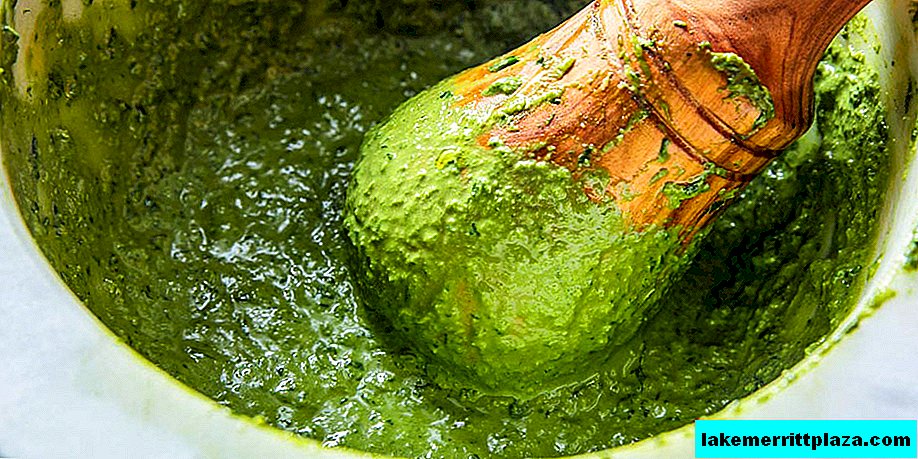Sauces are an integral link in the culinary traditions of Italy. Of course, the most important of them is Pesto. The Ligurian origin, whose basis is basil, serves as a companion for many dishes. Pesto Genovese (Genovese) - a classic performance of the sauce. But his recipe, like the whole world, does not stand still and is being improved, adapting to modern tastes. Do you want your kitchen music to acquire Italian notes? The “score” for Pesto is presented in our article.
Story
Despite the fact that Pesto is deeply rooted in Italian cuisine, its history began relatively recently. The first recipe for the sauce was released in the middle of the XIX century. The use of aromatic herbs for food is a practice that emerged among Ligurians in the Middle Ages. Wealthy people preferred gourmet spices, the poor hid the herbs with the not too pleasant taste of their dishes - this tradition became the foundation for creating basil pesto.
The plant of Arab origin has a curious botanical name - Ocimum basilicum, which means "royal grass".
First mention
It is believed that this recipe is an evolution of an older grated garlic sauce used in the 13th century.

Legend
But one cannot ignore the famous legend, according to which the monk who lived in the monastery of San Basilio, collected in the mountains aromatic basilium grass, named after St. Basil. Grinding it in a mortar with other components brought by the pilgrims, the ascetic received the first Pesto sauce.
During the 19th century, the recipe for Pesto sauce practically did not change and was very popular. But it is likely that the early version of the dish was different from the modern one with a large amount of garlic. This assumption is justified by two reasons: the Arab-Persian influence on the cuisine of Genoa, which lasted until the beginning of the 20th century, as well as the abundance of garlic food in the diet of Ligurian sailors.
In fact, thanks to the sea, Pesto also gained great popularity in the world. From the port of Genoa, merchant and passenger ships sailed to the countries furthest from Italy.
Kinds
Traditionally, if they say Pesto, then they mean genovese sauce (Pesto genovese). In its composition are invariably present: basil, pine nuts, cheese (Parmesan or Grana Padano and Fiore Sardo), salt, garlic and olive oil. But in addition to the classic version, there are types of sauce created taking into account the tastes of various dishes. Often, such pesto is made from products typical of the cooking area.
Ligurian
Ligurian Pesto (Pesto ligure) is a traditional product (Prodotto Agroalimentare Tradizionale) of the Liguria region. They make it on the basis of the Genoese basil (basilico genovese D.O.P.) - a special kind of aromatic herb with a more delicate taste compared to other varieties. In fact, the Ligurian Pesto is a copy of the Genovese sauce with less stringent component requirements. Ideal for pasta and some bruschettas.
Trapanese
Pesto alla trapanese (Pesto alla trapanese or agghiata trapanisa) is a typical Sicilian product, the recipe of which has been passed down by the locals from generation to generation. It arose thanks to the Genoese sailors who "presented" their Pesto to the residents of Trapani. The latter processed the recipe by adding components typical of their area, such as: tomatoes, almonds and dried fruits. Pesto trapanese goes well with pasta due to its delicate tomato flavor.
Pesto from Gargano
Pesto recipe, popular on the Gargano Peninsula, stands out among its brethren in that it includes basil replaced with turnip tops. Additional ingredients: garlic, chili pepper and olive oil. This sauce is considered a universal seasoning and is used for different types of pasta.
Pistachio
Pisto Pesto (Pesto di pistacchio) - a delicacy characteristic of the island of Sicily (Sicilia). For its preparation using pistachios di Bronte (pistacchio di Bronte) DOP, which are collected in the eponymous valley between the volcano Etna (Etna) and the mountains of Nebrodi (Monti Nebrodi). Nuts (60-80% of the total number of components) are ground with salt, pepper and olive oil. The sauce has an exquisite rich taste and goes well with first courses, pasta and various types of canapes.
With sicilian hazelnuts
Pesto with Sicilian hazelnuts (Pesto di nocciole siciliano) is a product of high gastronomy that can give an original shade to the first and second courses of both meat and fish. It is prepared by rubbing hazelnuts and sunflower seeds with salt, pepper, nutmeg and olive oil.
Features Pesto Genovese
Despite the fact that Pesto Genovese is not a DOP or IGP product, the preparation and sale of the sauce is subject to strict regulations that protect it from fakes. The rules govern the choice, the percentage of ingredients, the area of their production.
A product that does not meet all requirements cannot be called "Pesto Genovese".
Sauce Ingredients:
- Genilovese Basil DOP (Basilico Genovese DOP) - at least 25% of the total number of components;
- Extra Virgin Olive Oil Made in Italy;
- Parmigiano Reggiano DOP (Parmigiano Reggiano) or Grana Padano DOP (Grana Padano);
- Pecorino DOP (Pecorino);
- Garlic, pine nuts and sea salt;
- Walnuts are allowed.
Garlic and sea salt, like oil, must be produced in Italy. Walnuts - Collected in the European Union. For pine nuts (Pinus Pinea cedar), the collection area has been expanded to the Mediterranean region.
Finally, the final chord is cooking. Real Genoese sauce is made by grinding in a mortar. Electric mixers can heat components. Iron blades of knives oxidize basil, which negatively affects the taste of the product.
Characteristic
Each batch of Pesto Genovese can vary in color from dark to light green depending on the color of the basil. The texture of the sauce is rather dense and uniform, determined by the percentage of olive oil.
The real highlight of Pesto is its aroma. It is strong and persistent, but at the same time very thin thanks to the perfect combination of ingredients. Garlic notes come to the fore, which then dissolve in the enveloping scent of basil and cheese.
The taste is first dominated by the presence of aged cheeses, then turning into a spice of garlic and basil.
Pesto Genovese is used to flavor first and second courses and different types of pasta and, above all, the famous trofie, typical of Liguria.
As for drinks, it is worth noting that the product with garlic and basil "does not tolerate" combining with red wine, which will acquire a bitter metallic taste. Dry white wine should be chosen. For example, the Ligurian Pigato DOC.
Classic recipe
The classic recipe Pesto is very popular in the world. Not only because of its versatility, but also because the components that make up its composition can always be found on sale. Easy to prepare sauce is ideal as an accompaniment to summer dishes.
Ingredients:
- Basil leaves - 50 g
- Garlic - 2 cloves
- Pine Nuts - 15 g
- Hard cheese (Parmesan) - 70 g
- Sheep's milk cheese (Pecorino) - 30 g
- Olive oil - 100 ml or until the required consistency
- A pinch of coarse salt

From the indicated amounts of components, Pesto will be obtained for dressing about 600 g of pasta.
To start, wash and dry the basil by putting it on a paper towel. Such a seemingly simple procedure has pitfalls. We work as carefully as possible so as not to damage the leaves. Crumpled or broken basil quickly blackens and acquires a bitter taste.
Next, using a mortar and pestle, grind the garlic, having previously removed the core from it, with a few grains of salt to the state of gruel. Add the basil and the remaining salt and continue to knead in a circular motion.
When bright green juice stands out from the basil, put the pine nuts. We are working with the pestle again. For a richer taste, pine nuts can be fried a little in advance in a dry pan.
In the finale, continuing to stir, add grated cheese and olive oil. The sauce is ready.
Not all housewives in the kitchen have a mortar and pestle. While a blender is a regular in almost every apartment. But the use of an electric appliance to make Pesto can have a detrimental effect on the taste of the sauce. An easy life hack can save the situation. One hour before the start of the procedure, place the blender knives in the freezer. Grinding itself should be carried out with frequent stops. This will prevent the basil from heating and oxidizing during grinding.
Ready sauce is stored in the refrigerator for no more than 10 days or a little longer in the freezer, thawing at room temperature as necessary.
Calorie content and beneficial properties
Estimated calorie content of Pesto sauce 450-500 kcal per 100 g of product, in which:
- Protein - 5 g
- Fat - 12.7 g
- Carbohydrate - 46.9 g
The classic version of Pesto is a sauce rich in fats, many of which are very beneficial for humans. Monounsaturated fats normalize cholesterol. Polyunsaturated - help maintain the health and stamina of the body, and are also responsible for the beauty of the skin, hair and nails.
Basil - the main component of the dish - boasts a large amount of vitamin C, potassium, calcium, phosphorus. It has antioxidant, anti-inflammatory and antibacterial properties. A sufficient level of fiber ensures the proper functioning of the digestive tract.
Garlic fills the sauce with B vitamins, and pine nuts with zinc and iron.
With all the advantages of Pesto, do not forget about the presence of salt and cholesterol. In order for the dish to benefit not only the taste buds, but also the whole body, the average portion of the sauce for the pasta dish should not exceed 40-50 g (200-250 kcal).
All the "notes" of the famous sauce we have provided at your service. Perhaps the time has come to create your musical masterpieces on the kitchen stage. Sing loudest, love one another, enjoy the summer and remember: "The smell of fresh basil is the best song about Italy!"








